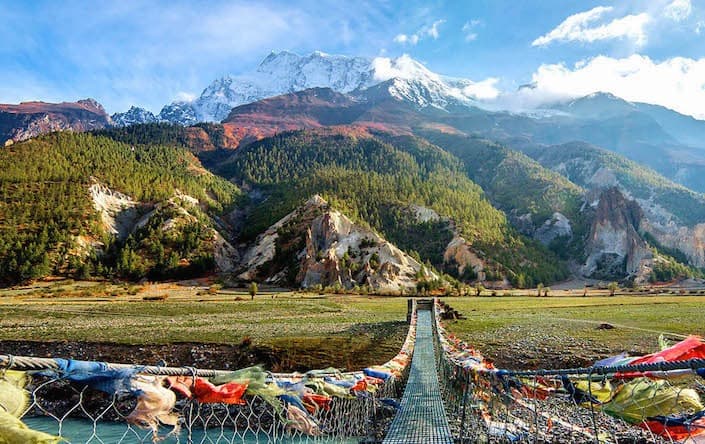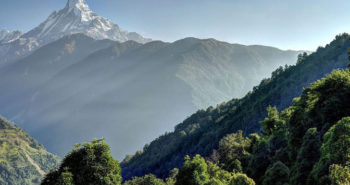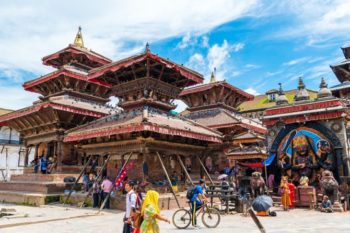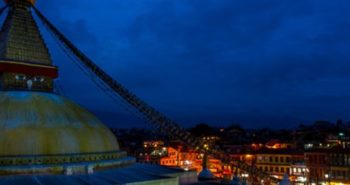Best Time to go Annapurna Circuit Trek
Having chosen the Annapurna Circuit Trek you want to know the best time to go, right?
There are real benefits and disadvantages for each season. You should think about the weather and whether you are an experienced trekker or not before fixing your plan, For example, the best time to go in terms of weather, vegetation, clear skies and ease of walking is, of course, the most popular and more trekkers will be on the trails. While we don’t recommend you do this trek in the winter, with the right gear and good preparation it is possible.
Here is a breakdown season by season.
Annapurna Circuit: Spring – March through May
This is the most popular time of the year for trekking in Nepal because of the clear weather and sunny days. Mornings and evenings will be cold when you are at higher altitudes but overall temperatures will range from 7 to 24oC, with an average of 15. There is no rain during this time and skies will be mostly clear.
The vegetation is in full bloom at this time of year. Nepal’s national flower, the rhododendron is found at lower altitudes and is particularly beautiful. Other wildflowers provide an array of colours and the pine forests at lower altitudes will be fresh and fragrant.
Annapurna Circuit: Monsoon – June through August

There is something wonderful that we love about monsoon! Vegetation is washed clean, and the snow-capped mountains are stunning in the mornings after a night of rain.
There will be times when the mountains will disappear behind rain clouds, but that just makes it all the more special when they do appear!
Teahouses remain open during this time, and with less trekkers around, accommodation is not a problem. You might even be able to get a cheaper rate than that advertised.
Temperatures are not so different from those of the springtime, being perhaps a bit less cold at the higher points of this trek. Expect temperatures around 9 to 24oC, with drops when it rains.
While there is rain at the lower altitudes, particularly on the Marpha to Pokhara part of this trek, the northern areas, including Manang, are in the rain shadow so see little rainfall. A good pair of walking shoes or trekking boots and trekking poles (sticks) will help you negotiate any slippery parts of the trail.
The disadvantages of trekking in the monsoon are the leeches (they do not pass disease but can cause infection if you scratch the bite site) and the fact the trails will be more slippery.
The main advantage of trekking in the monsoon is the fact you will not see many other trekkers. And we think that offsets those horrible little leeches! (Carry salt to remove them.) And drinking hot tea inside your teahouse watching the rain falling outside can be just as magical an experience as gazing at the mountains.
Annapurna Circuit: Autumn – October through November
This is another very popular time to go trekking in the Annapurnas. As a result, the trails will be busier. So again, off-set the weather and beauty of the surroundings with the fact the there will be more trekkers around and accommodations are at a premium. Temperatures are similar to spring, getting cooler as the season gets later. But expect in the region of 10 to 24oC, with an average of 15.
Also, bear in mind this is the main festival season in Nepal – sort of like the Western Christmas and New Year. So if you are planning to travel with a porter and/or guide, please make sure to book them in advance.
With peak trekking season and festival season falling at the same time, trekking staff is stretched to the limit! There are only 2 or 3 days however when things will be affected – such as less road transport during the main festival days. Please bear this in mind when planning your trek. On the other hand, you can enjoy the festive atmosphere along the way and in Pokhara.
Annapurna Circuit: Winter – December through February
There will be heavy snowfall at higher altitudes and the Thorong La Pass at 5,416m will be particularly hard to cross. If you have experience in trekking in winter, are very well prepared, don’t mind hiking through deep snow and are prepared to be damp some days, you might want to consider winter.
At this time the views will be spectacular (perhaps some cloudy days) and there will be hardly any trekkers on the trails. Temperatures at higher altitudes will be below freezing point at night. Teahouses remain open and with less trekkers on the trail you will have a choice of accommodation!
Read More: Best trekking destination to trek in Winter: January and February
What Kind of Weather Can I Expect on the Annapurna Circuit Trek?
This trek takes in both lower altitude and higher altitude hiking so the days will vary depending on where you are. The start and end of the Annapurna Circuit Trek will be warm and sunny while the midpoint will be colder, and perhaps with snow.
Here is a breakdown of the weather during different seasons to let you prepare.
Spring – March through May
The average temperature will be around 15oC, with it steadily getting warmer towards the end of May. At the lower altitudes expect days to be a warm 18-24o C. At higher altitudes expect the day time temperatures to be 4 to 5 Celcius. Nighttime temperatures may drop below freezing. There is no rain during this time and the skies will be clear.
Monsoon – June through August
Temperatures are not so different from those of the springtime, being perhaps a bit less cold at the higher points of this trek. Expect temperatures around 9 to 24oC, with drops when it rains.
Rivulets become streams and streams turn in to rivers, adding to the beauty of the trail. Vegetation is greener at the lower altitudes – fields come alive and forests are washed clean.
As parts of the Annapurna Circuit Trek lies in the rain shadow, despite it being monsoon at lower altitudes, the northern part of this trek sees less rain.
Rain will likely come into play on the Mustang side of the Thorong La Pass heading towards Pokhara. Landslides and muddy trails may be encountered. But this is balanced by the fact you will encounter fewer trekkers!
Autumn – October through November
Temperatures are similar to spring, getting cooler as the season gets later. But expect in the region of 10 to 24oC – temperate and comfortable at the lower altitudes. At higher altitudes chances of snowfall are low and the skies will also be sunny. This is also another very popular trekking season in Nepal.
Winter – December through February
These are the coldest months on the Annapurna Circuit Trek, with an average of 7-12oC. Temperatures will be below freezing at higher altitudes. The Thorong La Pass may be closed due to snowfall.
This is less likely in early December. There are chances of roads and trails being blocked by snow. So you should have an alternative plan and/or add in extra time in case these situations arise. Some days may be cloudy but on other days the air will be crisp and clear and mountains stunningly white against the blue sky.
We suggest you do not make the Annapurna Circuit in the winter your first ever trek! Higher altitude winter treks are possible for the more experienced trekkers but not advisable for those with no or little experience.
FAQ:
Spring: March-May
What is the best thing about the spring season?
Springtime on the Annapurna Circuit is best known for the Rhododendron flowers – they will be in bloom – and for the weather. The weather will be warm during the day and, at lower altitudes, not too cold at night.
Do I have to prepare for the cold?
Spring on the Annapurna Circuit Trek is not particularly cold. However crossing the Thorong La Pass at 5,416m will be cold and you should prepare for that with warm clothes such as down jacket, gloves, and hat
How cold does it get on the Thorong La Pass?
Temperatures can be -5 to -10 Celcius. Remember you will have to get up very early in the morning to do the crossing. There may be snow.
Is there any place to chill out and relax during the trek?
On the Annapurna Circuit Trek, if you are not in a rush and have a few days to spare, Muktinath and Kagbeni have quite laid back vibes. But the best place to chill out in Pokhara after the trek. With its vibrant nightlife, spas lake sidebars and restaurants this is the perfect place to relax after a trek.
How crowded will the trail be?
This is the best season for trekking in Nepal and as such is peak season. Trails will be busy. Accommodation will be at a premium so it is good to book ahead or ask your guide/ porter to arrange accommodation for you.
Summer/ Monsoon: June, July, August
Any recommendation for the summer season?
If you are flying back to Pokhara from Jomson allow an extra day or two in case of flight delay due to bad weather. This is monsoon, and there may be heavy rain in Pokhara.
See, Best trekking destination in Nepal in June
What should I expect during the monsoon season?
Expect rain and leeches at an elevation below 3,000m. If you are driving to Chame, expect a muddy off-road experience. There is little rain in the northern parts of the trek as it lies in the rain shadow.
Is there any way to check the weather before trekking the Annapurna Circuit?
Yes, you can check the weather forecast. However, it is not reliable. Things change very quickly in the mountains and we recommend you prepare for rain.
Will there be landslides on this trail?
No, this is not a landslide area. It is very unlikely to happen.
Do you recommend trekking alone in this season?
No, there will be fewer people on the trail. We recommend you to find trekking partners or hire a company during this season.
Is it safe to trek with children in the monsoon?
Yes, it is completely safe to trek with children in the monsoon, assuming that they have prior hiking experience. It could be uncomfortable for young children if they get wet. So consider this before setting off.
Autumn: September, October, November
What is so special about this season?
Basically, the weather! This is an equally popular time for trekking in Nepal due to the good weather, clear skies and sunny days. If you come around October/ November, you might see the largest Nepali festival – Dashain and Tihar. Make sure to check a Nepali calendar as the dates change every year.
Any recommendation for this season?
As this is one of the busiest seasons in Nepal, we recommend you book your trek well in advance. If you are hiking independently, carry a local sim card and make sure to ask the contact of the teahouses/ hotels you wish to stay at. Call them and tell them you are on the way (the same day) and book the accommodation.
Winter: December, January, February
Is it possible to cross Thorong la Pass during the winter?
In general yes, it is possible to cross the Thorong La during the winter. There may be times when it will be closed due to heavy snowfall. Make an alternative plan in case this happens.
What do you recommend in way of gear in the winter?
Microspikes/crampon and warm clothes. Some waterproof clothing and boots are recommended also.


